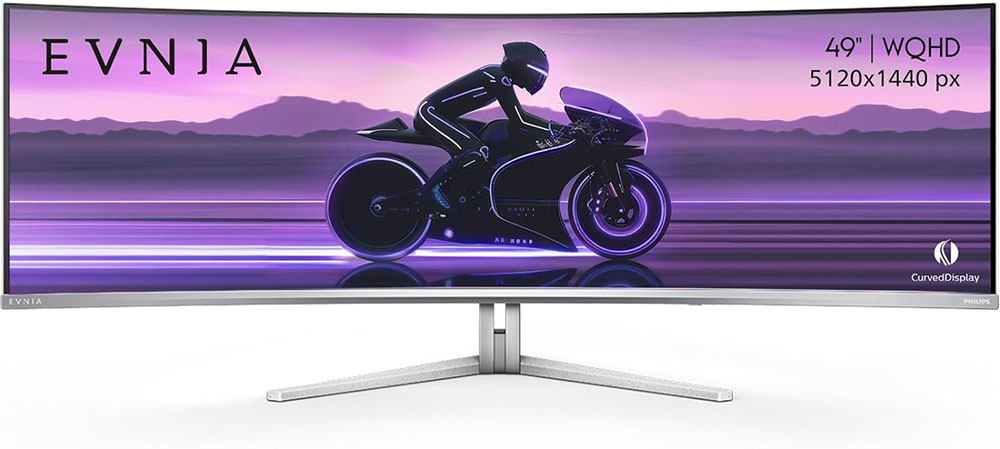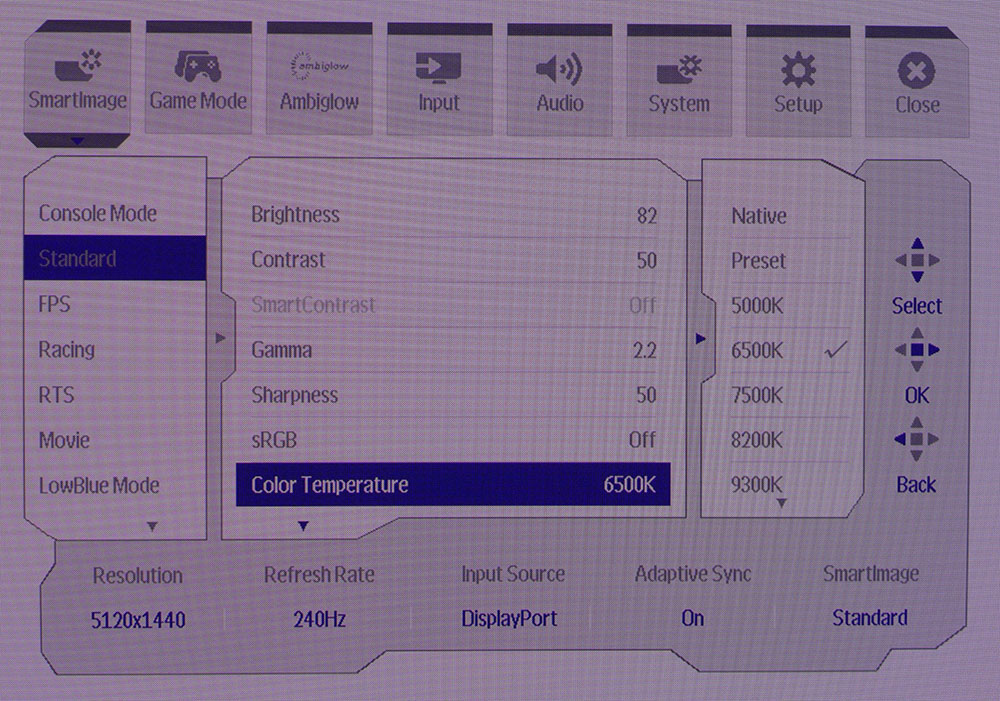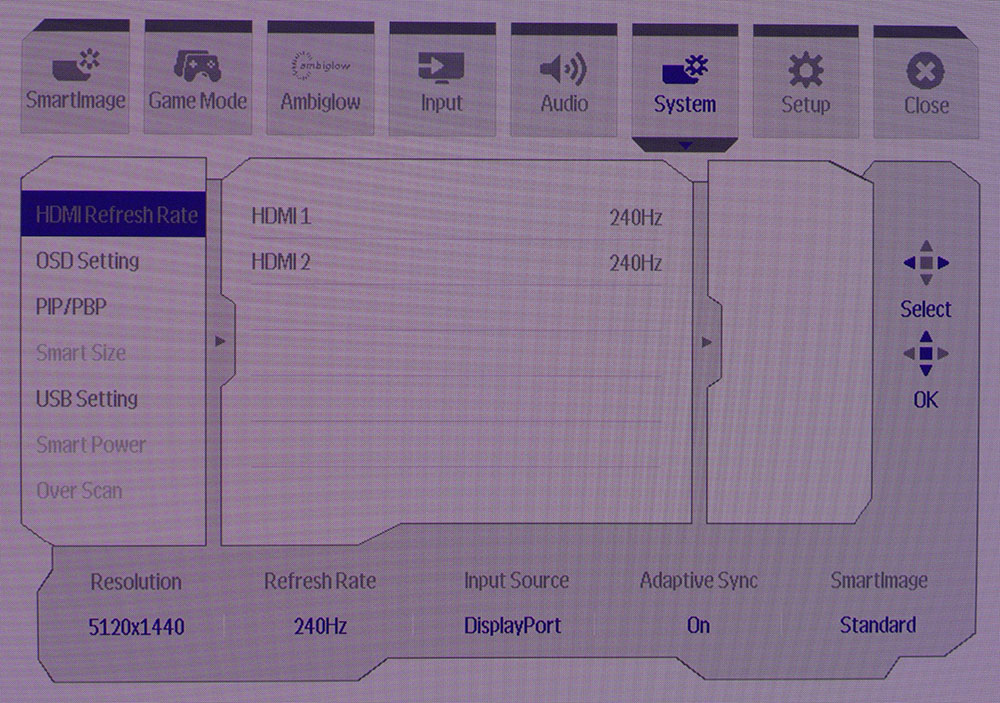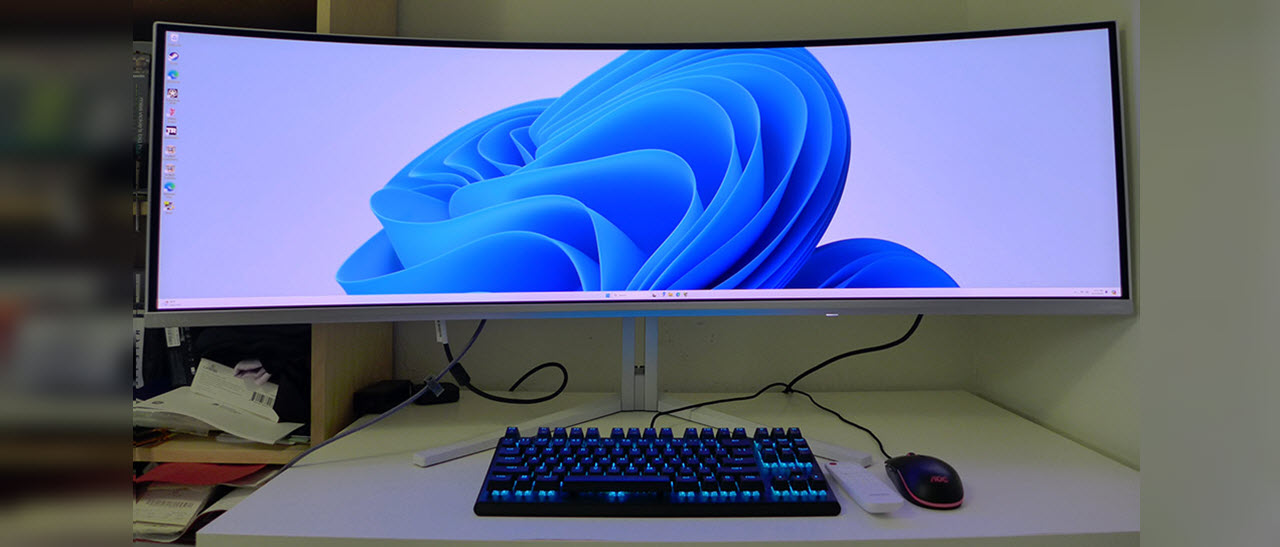Tom's Hardware Verdict
The Philips Evnia 49M2C8900 has a couple of minor flaws but with a stunning picture, next-level gaming performance and killer audio, they are forgiven. It’s a seriously addictive gaming monitor.
Pros
- +
Crisp image with vivid and accurate color
- +
No calibration required
- +
Smooth and speed motion processing
- +
Excellent built-in audio with four speakers
- +
Handheld remote
- +
Excellent build quality and styling
Cons
- -
Some crushed shadow detail in HDR content
- -
No RGB sliders to tweak color temp
Why you can trust Tom's Hardware
There’s no denying that 49-inch 32:9 monitors are cool. Once you find a space large enough to accommodate on, and unpack the coffin-like carton, they provide a view into the virtual world like no other class of display.
The only thing more remarkable than a 49-inch gaming monitor is a 49-inch OLED gaming monitor. Adding in that special panel with its infinite contrast, true blacks, and saturated color takes the experience to another level. The latest OLEDs include Quantum Dots in their designs for even more color among the best ultrawide gaming monitors. 100% of DCI-P3? Try 114%. That’s how much coverage I measured from my present subject, Philips’ Evnia 49M2C8900. It’s a DQHD, 5120x1440 resolution screen with 240 Hz, Adaptive-Sync, HDR400 and wide gamut color. Let’s take a look.
Philips Evnia 49M2C8900 Specs
| Panel Type / Backlight | Quantum Dot Organic Light Emitting Diode (QD-OLED) |
| Screen Size / Aspect Ratio | 49 inches / 32:9 |
| Row 2 - Cell 0 | Curve radius: 1800mm |
| Max Resolution and Refresh Rate | 5120x1440 @ 240 Hz |
| Row 4 - Cell 0 | FreeSync: 48-240 Hz |
| Row 5 - Cell 0 | G-Sync Compatible |
| Native Color Depth and Gamut | 10-bit / DCI-P3 |
| Response Time (GTG) | 0.03ms |
| Brightness (mfr) | 250 nits SDR |
| Row 9 - Cell 0 | 450 nits HDR |
| Contrast (mfr) | Unmeasurable |
| Speakers | 4x 7.5w, DTS-tuned |
| Video Inputs | 1x DisplayPort 1.4 |
| Row 13 - Cell 0 | 2x HDMI 2.1 |
| Row 14 - Cell 0 | 1x USB-C |
| Audio | 3.5mm headphone output |
| USB 3.2 | 1x up, 4x down |
| Power Consumption | 78.5w, brightness @ 200 nits |
| Panel Dimensions WxHxD w/base | 47 x 16.5-21.2 x 14.1 inches (1195 x 419-538 x 359mm) |
| Panel Thickness | 7.1 inches (181mm) |
| Bezel Width | Top: 0.3 inch (10mm) |
| Row 21 - Cell 0 | Sides: 0.6 inch (14mm) |
| Row 22 - Cell 0 | Bottom: 0.9 inch (23mm) |
| Weight | 30.8 pounds (14kg) |
| Warranty | 3 years |
At this writing, a 49M2C8900 will set you back around $1,500. That’s competitive with other 49-inch OLEDs like the Asus PG49WCD, but the Philips runs at 240 Hz versus 144 Hz. 240 Hz OLEDs have proven to deliver the best video processing and smoothest gameplay. They render perfect motion resolution, which means moving objects have no blur and retain their full detail. Rapid camera pans don’t break up background textures, and input lag is extremely low.
As a Quantum Dot OLED, the 49M2C8900 renders a massive color gamut. Philips claims 99% coverage of DCI-P3, but I measured over 114%, making it one of the most colorful panels I’ve ever tested. Accuracy is assured by a factory calibration supported by an included data sheet for each sample. Mine measured up as promised, so no adjustment was required.
The 49M2C8900 isn’t the brightest monitor in its class, but it tops 400 nits in HDR mode. That is about the same output I’ve seen from other 49-inchers. If you want significantly higher brightness, the 45-inch Corsair Xeneon Flex and AOC AG456UCZD deliver 1,000 and 600 nits, respectively. But in practice, the 49M2C8900 has the same superb HDR quality as every OLED I’ve seen.
The curve radius is a not-too-extreme 1800R, making the 49M2C8900 well-suited for work and play. With 5120x1440 DQHD resolution, it is the exact equivalent of two 27-inch 16:9 QHD panels. So, you get the same screen area but with a curve and no dividing line, neat.
The 49M2C8900 wouldn’t be complete without some form of Philips’ Ambiglow feature. An array of LEDs rings the back of the monitor and casts color and light on the wall behind. You can have a static bias light or a variety of breathing and flashing effects, or sync the light show with what’s happening on-screen. No gaming monitor has lighting this flexible and fun.
Get Tom's Hardware's best news and in-depth reviews, straight to your inbox.
HDMI 2.1 and DisplayPort 1.4 inputs support the latest signal formats, and you get a USB-C that covers DisplayPort functions. A USB hub is included with one upstream and four downstream ports, two of which provide power for charging. You also get a handy remote control which makes OSD navigation a snap. And the chassis is finished in white with silver trim making it stand out among the legions of black monitors that adorn most desktops.
Assembly and Accessories
The 49M2C8900 comes packed in large blocks of crumbly foam. The panel is well protected, so much so that I had to attach the stand while it was still in the box and lift it out. 49-inch monitors are awkward to unpack, and this is the best way to get everything set up safely. You’ll need to find the two bolts that secure the upright to the panel’s attachment point. A Phillips-head screwdriver is included. If you want to use an arm, there’s an adapter bracket with a 100mm VESA mount. The included cables are light gray to match the white finish. You get one each of DisplayPort, HDMI, USB-C, USB-A/B, and an IEC power cord. I also found a small handheld remote in the box with batteries included.
Product 360






At a hair shy of four feet wide, the 49M2C8900 requires some extra desktop space. But it makes a great alternative to two 27-inch 16:9 screens. The white and silver finish is a nice touch that isn’t seen too often. It’s a welcome change to the black and gray of so many other displays. The front bezel is flush and narrow. The screen is very glossy and will pick up stray reflections if you have bright lights or sunny windows. Placement should be carefully considered so you don’t spoil that stunning image. The curve is ideal for gaming or productivity and wraps the screen around the user’s viewpoint without image distortion.
With 109ppi pixel density, sharpness is no problem. The picture is crystal clear and extremely colorful. As it is an OLED, there is no color or light level change when viewed off-axis. This is the ideal tech for an ultra-wide screen. To control the OSD, you can reach around the back right to find the 49M2C8900’s tiny joystick. Or better yet, use the included remote, which is white and comes with batteries.
From the side, you can see the stand hardware, which is reasonably solid, though the attachment point is a bit small. There is some wobble when making adjustments. You get full ergonomics with 4.8 inches of height, 20 degrees of swivel, and 5/15 degrees of tilt. Movements are firm, and once you get the panel positioned, it stays put. At the top of the stand is a headphone hoo,k, and at the bottom, a small cable clip.
The input panel is fully stocked with two HDMI 2.1, one DisplayPort 1.4, one USB-C with DP functions, and a USB hub with one upstream and four downstream ports. You also get a 3.5mm headphone jack. There are four internal speakers, two tweeters, and two ported woofers with 7.5 watts of power each. The 49M2C8900 has some of the best integrated audio I’ve heard short of a high-end television. DTS processing is in the mix with sound modes and a multi-band equalizer. The speakers are far enough apart to create a believable surround effect. And there is plenty of distortion-free volume available.
OSD Features
You can summon the 49M2C8900’s OSD by pressing the joystick in back or keying the remote. There are seven sub-menus along with signal information on the bottom.









Each picture mode (SmartImage) has its own independent settings for brightness/contrast, gamma, sharpness and color temp. There are no RGB sliders or color management, but the default Standard mode is well within spec out of the box. The full color gamut is in play for SDR and HDR content unless you turn on sRGB which then accurately renders that colorspace.
Game Mode includes a selection of crosshairs and an option to change color on the fly so it remains in contrast with the background. You can also boost shadow detail if you’re having difficulty seeing in the dark. A sniper mode provides three magnifications and can be positioned anywhere on the screen.
Ambiglow is the LED lighting feature, and it has many settings that change both color and effect. The coolest way to use it is to coordinate it with the on-screen action. It changes in real-time and extends the image past the edge of the screen. It can also be used as a bias light, which has science behind it. A soft white glow against a neutrally colored wall increases the perception of sharpness by enlarging the viewer’s pupils slightly. I use this technique with my TV and projector screen at home and it is very effective.
Philips has really pulled out the stops for the 49M2C8900’s audio. The four internal speakers include five sound modes that alter the size and shape of the stage to suit different content. It works quite well and increases the sense of immersion and suspension of disbelief when gaming. It’s useful for watching movies and TV content as well. If you like to tweak, a five-band equalizer is included too.
To guard against OLED burn-in, the 49M2C8900 has a pixel orbiter, screen saver and refresh routine. The refresh will run every four hours if you wish. A message comes on to let you know and you can opt out if you want. In my experience, I have yet to see burn-in on any OLED monitor or TV.
Philips Evnia 49M2C8900 Calibration Settings
The 49M2C8900 has 10 task-specific picture modes, but Standard, the default, is the best choice for gaming or productivity. HDR signals enable five additional modes. In Standard, you can select color temps by Kelvin value and choose a gamma preset. To stay on-spec, leave it set to 6500K and 2.2. If you want the correct sRGB color gamut for SDR, turn that option on. There is no user color temp nor is there color management, so a full calibration is not possible. But it is not needed either. Below are the brightness settings for commonly used output levels. There is no dimming option for SDR; the SmartContrast feature is grayed out in every mode.
Dynamic contrast is in play for HD, raising the peak to 438 nits. You can adjust brightness, contrast and color saturation in three of the modes. I noted significant black crush in all modes which obscures the darkest shadow detail. To get the most out of the 49M2C8900’s HDR, some in-game adjustments are required.
| Picture Mode | Standard |
| Brightness 200 nits | 82 |
| Brightness 120 nits | 39 |
| Brightness 100 nits | 28 |
| Brightness 80 nits | 17 |
| Brightness 50 nits | 3 (min. 47 nits) |
| Contrast | 40 |
| Gamma | 2.2 |
| Color Temp | 6500K |
Gaming and Hands-on
Being a 240 Hz OLED, I’m predisposed to like the 49M2C8900. The combination of low input lag and perfect motion resolution is addictive. Aiming and shooting is so much more precise than any LCD panel short of 500 Hz. The picture is super crisp and colorful, with incredible depth and texture. The best Mini LED might approach this level of quality, but it won’t quite get there. Currently, OLED has no equal in contrast.
Adaptive-Sync is no problem whether you run Nvidia or AMD. I pegged the frame counter at 240 with a GeForce RTX 4090. You’ll need some horsepower to move 7.37 million pixels around. It’s fewer than Ultra HD but twice as many as QHD. If you’re shopping for 49-inch monitors, though, you want 240 Hz. 144 Hz by visual comparison is too blurry. The 49M2C8900’s motion resolution is perfect at all times. I never saw any blur or breakup of background textures or foreground objects. Once you play like this, no other monitor will do.
The screen’s width and curvature easily fill one’s peripheral vision. I play shooters to test monitors, and Doom Eternal was enough to keep me playing for hours. If you are a racing and driving sim fan, this is your monitor. You can look down to the apex of a corner as if you were in an actual car. The 49M2C8900 enables you to look where you want to go.
I noted some crushed shadow detail when tweaking the in-game controls, as I usually do. You can read about this on page five of this review. To see all shadow areas in the game, you must increase black levels. Otherwise, some detail will be lost. I noted this issue in videos played through web browsers and through an Apple TV 4K. It only showed up in HDR mode. SDR content played without problems. I appreciated having the choice to turn on sRGB when the SDR color looked too saturated.
The 49M2C8900’s best feature apart from the gorgeous image, is its built-in sound. It is easily the best I’ve heard to date, thanks to four speakers and actual bass. Two of the speakers are termed woofers and they delivered frequencies I had not heard before from monitor speakers. The DTS sound modes came in handy for expanding the sound stage. The Shooter option really helped when playing Doom Eternal. I could actually differentiate the music from the other sounds. This made the experience much more immersive and cinematic.
For workday tasks, the 49M2C8900 behaves just like two 27-inch QHD monitors. The curve isn’t enough to cause distortion and there are no issues with off-axis viewing. You can put documents anywhere on the screen and read them easily.
Takeaway: The 49M2C8900 is appropriate for any application, game, video or productivity. Its color is exemplary with high saturation and accuracy. SDR and HDR contrast are both superb, but HDR has some shadow detail issues that must be compensated for with in-game adjustments. I did this successfully and had an addictive play experience thanks to its 240fps performance and perfect motion resolution. This is a gaming monitor that you won’t want to part with.
MORE: Best Gaming Monitors
MORE: How to Buy a PC Monitor
MORE: How to Choose the Best HDR Monitor
Current page: Features and Specifications
Next Page Response, Input Lag, Viewing Angles and Uniformity
Christian Eberle is a Contributing Editor for Tom's Hardware US. He's a veteran reviewer of A/V equipment, specializing in monitors. Christian began his obsession with tech when he built his first PC in 1991, a 286 running DOS 3.0 at a blazing 12MHz. In 2006, he undertook training from the Imaging Science Foundation in video calibration and testing and thus started a passion for precise imaging that persists to this day. He is also a professional musician with a degree from the New England Conservatory as a classical bassoonist which he used to good effect as a performer with the West Point Army Band from 1987 to 2013. He enjoys watching movies and listening to high-end audio in his custom-built home theater and can be seen riding trails near his home on a race-ready ICE VTX recumbent trike. Christian enjoys the endless summer in Florida where he lives with his wife and Chihuahua and plays with orchestras around the state.
